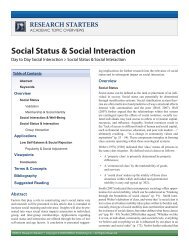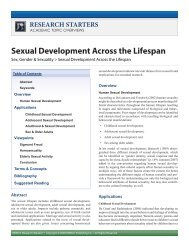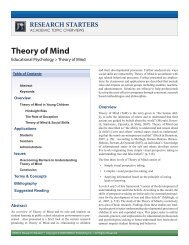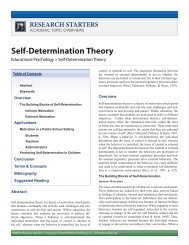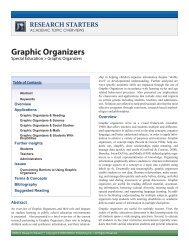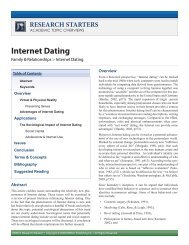Academic Learning Time - DSWLeads.com
Academic Learning Time - DSWLeads.com
Academic Learning Time - DSWLeads.com
- No tags were found...
You also want an ePaper? Increase the reach of your titles
YUMPU automatically turns print PDFs into web optimized ePapers that Google loves.
RESEARCH STARTERS<br />
ACADEMIC TOPIC OVERVIEWS<br />
<strong>Academic</strong> <strong>Learning</strong> <strong>Time</strong><br />
Curriculum Organization > <strong>Academic</strong> <strong>Learning</strong> <strong>Time</strong><br />
Table of Contents<br />
Abstract<br />
Abstract<br />
Keywords<br />
Overview<br />
<strong>Academic</strong> <strong>Learning</strong> <strong>Time</strong> Today<br />
High Probability & Low Probability Tasks<br />
Homework<br />
Applications<br />
Students<br />
Teachers<br />
Administrators<br />
Issues<br />
Over<strong>com</strong>ing Barriers to Efficient Uses of <strong>Academic</strong><br />
<strong>Learning</strong> <strong>Time</strong><br />
Conclusion<br />
Terms & Concepts<br />
Bibliography<br />
Suggested Reading<br />
An overview of <strong>Academic</strong> <strong>Learning</strong> <strong>Time</strong> and its role and impacts<br />
on student learning in public school education environments is<br />
presented. Also presented is a brief overview of the research<br />
substantiating appropriate <strong>Academic</strong> <strong>Learning</strong> <strong>Time</strong> and its<br />
relationship to specific subjects. Further analyzed are ways transitions<br />
impact <strong>Academic</strong> <strong>Learning</strong> <strong>Time</strong> and specific research<br />
based high probability and low probability task sequences are<br />
presented that offer options for success in learning environments.<br />
Applications that include roles and impacts on certain groups<br />
including students, teachers, and administrators are outlined.<br />
Solutions are offered to help them develop the most effective<br />
programs through consistent, research based methodologies that<br />
includes time-on-task, homework, and student achievement.<br />
Overview<br />
<strong>Academic</strong> <strong>Learning</strong> <strong>Time</strong> can be described as the amount of time<br />
a student spends engaged in an academic task that the student<br />
performs with high success (Fisher, Marliave, & Filby, 1979, p.<br />
52). <strong>Academic</strong> <strong>Learning</strong> <strong>Time</strong> might also be described as relevant<br />
time a student spends engaging in academic tasks while<br />
performing those tasks with a high rate of success. <strong>Academic</strong><br />
<strong>Learning</strong> <strong>Time</strong> tends to vary with the length of the school year,<br />
the number of hours in a school day, the amount of abseentism,<br />
and the time it takes to transition from one class to another and<br />
organize class activities (Brandt & Gunter, 1981, p. 151). The<br />
basic elements of <strong>Academic</strong> <strong>Learning</strong> <strong>Time</strong> include “allocated<br />
time, student engagement, and student success rates” (Fisher,<br />
Mariave, & Filby, 1979, p. 52). Central to understanding <strong>Academic</strong><br />
<strong>Learning</strong> <strong>Time</strong> is how <strong>Academic</strong> <strong>Learning</strong> <strong>Time</strong> directly<br />
impacts student learning. Teachers are key facilitators in providing<br />
the most appropriate <strong>Academic</strong> <strong>Learning</strong> <strong>Time</strong> for each<br />
subject; therefore, teachers and administrators must understand<br />
the importance of these roles and plan lessons accordingly to<br />
maximize time-on-task behaviors by easing transitions and<br />
thereby increasing student success.<br />
<strong>Academic</strong> <strong>Learning</strong> <strong>Time</strong> occurs when the conditions of allocated<br />
time, student engagement, and student success rates are applied<br />
simultaneously. These three ingredients of <strong>Academic</strong> <strong>Learning</strong><br />
<strong>Time</strong> are essential to student achievement. In order to facilitate<br />
understanding of how each of these ingredients contributes to student<br />
achievement, a definitional understanding must be provided.<br />
First, allocated time for a given activity is typically a block of<br />
time that is set by the teacher. Allocated <strong>Time</strong> might be decided<br />
individually by students or jointly between the teacher and the<br />
student. Allocations of time may be different or individualized for<br />
specific students in the same classroom. Second, Engaged <strong>Time</strong><br />
EBSCO Research Starters ® • Copyright © 2008 EBSCO Publishing Inc. • All Rights Reserved
<strong>Academic</strong> <strong>Learning</strong> <strong>Time</strong><br />
Essay by Sharon Link, Ph.D.<br />
Keywords<br />
Allocated <strong>Time</strong><br />
High Probability Task Sequences<br />
Low Probability Task Sequences<br />
Student Engagement<br />
Student Success Rate<br />
Transitions<br />
occurs during a portion of Allocated <strong>Time</strong> when students are<br />
paying attention. Typically, during Engaged <strong>Time</strong>, students will be<br />
“manipulating something, reading, thinking, interacting with other<br />
students, or in some way processing information about the task.”<br />
Third, the Student Success Rate occurs when there is a strong correspondence<br />
between Engaged <strong>Time</strong> and the task the teacher is<br />
asking the student to <strong>com</strong>plete. For example, if the task is so difficult<br />
that the student produces few correct responses, then limited<br />
learning will take place. In contrast, if a student produces many<br />
correct responses, then it would indicate that the child is learning<br />
(Fisher, Marliave, & Filby, 1979, p. 52). This would suggest that<br />
the evidence of student success is precipitated through multiple<br />
events occurring at the same time.<br />
More current literature continues to support evidence of a strong<br />
correlation between time and achievement. However, some literature<br />
indicates that Allocated <strong>Time</strong> refers to the total number<br />
of days or hours students are required to attend school. Engaged<br />
<strong>Time</strong> refers to the part of the day when students are participating<br />
in learning activities. Student Success or <strong>Learning</strong> refers to the<br />
time during Engaged <strong>Time</strong> when the material is neither too easy<br />
nor too hard and instructional activities are challenging, but still<br />
allow for success. Despite the thirty years of consistent thinking<br />
that Allocated <strong>Time</strong> produces a strong connection to student<br />
achievement, research now suggests inconsistencies with this<br />
previous theory (“Making <strong>Time</strong> Count,” 2001).<br />
<strong>Academic</strong> <strong>Learning</strong> <strong>Time</strong> Today<br />
In reconsidering the time element in student achievement, it has<br />
now been determined that other key factors besides time also<br />
influence student learning. These factors include:<br />
• Improving classroom management in order to minimize<br />
disruptions or disciplinary actions;<br />
• Ensuring developmental appropriateness of curriculum<br />
and instruction in order to maximize student thinking<br />
and match content with readiness for learning; and<br />
• Increasing student motivation by offering instructional<br />
activities that maximize interest and limit repetitive<br />
activities (“Making <strong>Time</strong> Count,” 2001).<br />
Overall, each of these three interventions has been identified<br />
as key indicators for motivating students and constructing student<br />
success.<br />
Additional evidence suggests that increased achievement is not<br />
necessarily derived from more time in school, but instead directly<br />
correlates with maximized <strong>Academic</strong> <strong>Learning</strong> <strong>Time</strong>. Another<br />
key factor that leads to success in academic learning environments<br />
is the possibility of extending the school day or school<br />
year, particularly for specific groups that may need intensive<br />
support. This factor alone has led to increased student achievement.<br />
Also, important to recognize, Engaged <strong>Time</strong> must also be<br />
maximized, because Allocated <strong>Time</strong> on its own does not lead to<br />
substantial achievement gains (“Making <strong>Time</strong> Count,” 2001). In<br />
order to maximize student success; this evidence suggests that<br />
more than just three factors lead to student achievement. Rather<br />
than only three variables, research has now established the critical<br />
aspects of how time is spent and what happens during each<br />
aspect of the instructional day.<br />
The most recent research has identified transitions and efficiency<br />
as key indicators of facilitating increased achievement. Given<br />
the current landscape of educational responsibilities, state mandated<br />
academic standards, and high stakes testing, educational<br />
professionals must be able to access evidence based strategies<br />
for helping children transition quickly and and keep them<br />
engaged longer. Paine, Rosellini, Deutchman, and Darch (1983)<br />
suggested that “smooth transitions provide more time for academic<br />
instruction and reduce” behavior management dilemmas<br />
(in Lee, 2006, p. 313).<br />
While multiple options exist for educators to use, one specific<br />
technique has produced evidence that helps students ac<strong>com</strong>plish<br />
initiating tasks faster and stay engaged longer (Lee, 2006, p. 313).<br />
These involve high probability tasks and low probability tasks.<br />
High Probability & Low Probability Tasks<br />
According to Lee (2006), High-probability (High-P) request<br />
sequences, when employed effectively, make it more likely that<br />
non-preferred behaviors will occur. To initiate this intervention, “a<br />
series of brief requests with a high probability of <strong>com</strong>pliance is<br />
administered just prior to a request with a Low Probability (Low-P)<br />
of <strong>com</strong>pliance” (p. 313).<br />
High-P requests include asking students to take out a pencil, write<br />
their name on a sheet of paper, and writing the date at the top of the<br />
paper. These High-P requests will be initiated just prior to requesting<br />
students to begin their math seatwork, which is arguably a Low-P<br />
request. Research from multiple studies suggests that engaging a<br />
series of High-P Requests just prior to initiating a Low-P Request<br />
will carry over and increase <strong>com</strong>pliance to a request that previously<br />
resulted in non-<strong>com</strong>pliance (Lee, 2006, p. 313). These High-P<br />
request sequences have been observed across populations and<br />
have included young children with behavioral problems (Davis &<br />
Reichle, 1996), special education populations (Harchick & Putzier,<br />
1990), and general education students (Ardoin, Martens, & Wolfe,<br />
1999). As outlined in Lee (2006), observed requests included:<br />
EBSCO Research Starters ® • Copyright © 2008 EBSCO Publishing Inc. • All Rights Reserved Page 2
<strong>Academic</strong> <strong>Learning</strong> <strong>Time</strong><br />
Essay by Sharon Link, Ph.D.<br />
• Self care (Mace & Belfiore, 1990),<br />
• Communication (Davis, Brady, Hamilton, McEvoy,<br />
& Williams, 1994; Sanchez-Fort, Brady, & Davis,<br />
1995), and<br />
• Transition from activity to activity (Ardoin et al.,<br />
1999), and intervenors (Mace & Belfiore, 1990).<br />
Experimentors include, but are not limited to,<br />
• Classroom teachers (Ardoin et al., 1999),<br />
• Parents (Ducharme & Worling, 1994), and<br />
• Same-age peers (Davis & Reichle, 1996).<br />
All of the results have previously been limited to self-care and<br />
<strong>com</strong>munication and have only recently been used in school settings,<br />
which have strong indicators for student academic success<br />
(Lee, 2006, p. 313).<br />
The High-P request intervention is based on the Theory of Behavioral<br />
Momentum (Nevin, 1996) which describes the “dynamic of<br />
behavior intervention in changing environments” (Nevin, Mandell,<br />
& Atak, 1983). Interestingly, Nevin “theorized that behavior possesses<br />
a momentum much like that found in physical objects” (cited<br />
in Lee, 2006, p. 313). According to Nevin’s theory, behavioral<br />
momentum is impacted by behavioral mass, which is “determined<br />
by the level of reinforcement associated with a specific stimulus<br />
condition” (cited in Lee, 2006, p. 313). In contrast, behavioral<br />
velocity has been determined as the “rate of response” attributed<br />
to specific behaviors. These similarities with physics indicate that<br />
“engaging in a series of tasks with a high probability of occurrence<br />
increases the overall rate of responding and subsequent reinforcement<br />
for a given task which subsequently results in increased<br />
<strong>com</strong>pliance to less preferred steps or problems within that same<br />
task” (Lee, 2006). The overall goal in thinking about behavioral<br />
momentum in terms of transition directly relates to how students<br />
respond during a given activity and offers specific approaches to<br />
increasing student productivity during transitions from one favorable<br />
activity to a perhaps less than favorable activity. Each of these<br />
sequences and their relationship to maximizing <strong>Academic</strong> <strong>Learning</strong><br />
<strong>Time</strong> by minimizing off task behaviors during transition times suggests<br />
strong indicators for educational professionals. Homework is<br />
another <strong>com</strong>ponent of <strong>Academic</strong> <strong>Learning</strong> <strong>Time</strong> that is not readily<br />
addressed in the literature.<br />
Homework<br />
Simons (1989) considered two main goals that homework should<br />
emphasize which include the “didactic and pedagogic function”.<br />
The didactic function aspires to improve learning processes.<br />
Homework that may be used to improve the didactic function<br />
teaches students how to study independently. The “pedagogic<br />
function aims to teach students how to study independently”<br />
(cited in De Jong, Westerhof & Creemers, 2000, p. 132). According<br />
to multiple scholars, homework has a direct impact on<br />
positive achievement. In defining homework academic achievement<br />
time, teachers should remember that a homework policy<br />
should be developed to produce best out<strong>com</strong>es. A homework<br />
policy is a logical system of written rules and procedures. In outlining<br />
the goals and importance of homework, teachers should<br />
offer motivational strategies for how to stimulate doing homework,<br />
expectations for how to evaluate homework, role plays<br />
on how to offer feedback, and a pre-set lessons on how to do<br />
homework. Additionally, teachers should offer a time frame on<br />
<strong>com</strong>pleting homework, and an outlined expectation from parents<br />
(de Jong, Westerhof & Creemers, 2000).<br />
Homework policies should include guidelines for helping students<br />
solve problems about their homework which might include:<br />
inadequate planning, difficulties in <strong>com</strong>pleting homework<br />
because homework is too difficult, and students not <strong>com</strong>pleting<br />
homework at all. For teachers the most problematical issues are<br />
related to differentiated instruction, controlling how homework<br />
is done, and motivating students to do their homework and how<br />
to study (de Jong, Westerhof & Creemers, 2000, p. 135). According<br />
to other researchers, homework policies are effective and<br />
promote student success and indicate that teachers who give “a<br />
lot of homework to students have a higher average achievement<br />
level than schools where the amount is low” (p. 135). Teachers<br />
need to remember that homework is a <strong>com</strong>plex issue and much<br />
debate continues regarding parental perceptions of homework<br />
and student levels of independence. Homework needs to be relevant<br />
about what has been pre-taught at school. Collaboration<br />
with grade level teams would also help alleviate parental concerns<br />
and create connectivity.<br />
Applications<br />
Students<br />
<strong>Academic</strong> <strong>Learning</strong> <strong>Time</strong> and Student Achievement are<br />
significant in implications for students in Public Education Environments.<br />
Given that “children are not small adults who only<br />
need to know more, but are unique human beings who move<br />
through predictable stages of development” a requirement is<br />
needed for adults to offer alternative methods of teaching, varieties<br />
of instructional materials and strategies, inquiry based models<br />
of instruction, and an increased awareness of specific Piagian<br />
levels of development (Brandt & Gunter, 1981, p. 151). Further<br />
needed are specific ac<strong>com</strong>modations for children with specific<br />
types of learning problems.<br />
Mainstreaming can impact student learning in various ways both<br />
for general education students and special education students.<br />
Multiple concerns are presented in providing optimum and differentiated<br />
<strong>Academic</strong> <strong>Learning</strong> <strong>Time</strong> for all children in a Public<br />
Education Environment (Brandt & Gunter, 1981). Additionally,<br />
specific subjects, including reading and math can be examined<br />
in terms of <strong>Academic</strong> <strong>Learning</strong> <strong>Time</strong> and student engagement.<br />
For students learning these subjects, instructional time can vary<br />
depending on goals and objectives. Teachers must know their<br />
students in order to differentiate appropriately.<br />
Teachers<br />
The use of <strong>Academic</strong> <strong>Learning</strong> <strong>Time</strong> has multiple implications<br />
EBSCO Research Starters ® • Copyright © 2008 EBSCO Publishing Inc. • All Rights Reserved Page 3
<strong>Academic</strong> <strong>Learning</strong> <strong>Time</strong><br />
Essay by Sharon Link, Ph.D.<br />
for teachers. In evaluating the best use of <strong>Academic</strong> <strong>Learning</strong><br />
<strong>Time</strong>, teachers need to understand how <strong>Academic</strong> <strong>Learning</strong> <strong>Time</strong><br />
is assessed, and teachers need to establish ways to ac<strong>com</strong>plish<br />
appropriate planning time. Teachers also need to know ways of<br />
conducting task analyses of instructional materials and establishing<br />
an observation system for monitoring time-on-task for individual<br />
pupils. For the practicing teacher, several essential concepts and<br />
skills would help teachers construct more effective <strong>Academic</strong><br />
<strong>Learning</strong> <strong>Time</strong>. Some of these concepts and skills that are helpful<br />
include curriculum analysis and design, selecting specific learning<br />
objectives, integrating an appropriate use of technology, learning<br />
alternative teaching methodologies, and appropriating inquiry<br />
based methods of instruction (Brandt & Gunter, 1981, p. 151).<br />
Research has clearly indicated that teachers who wish to maximize<br />
<strong>Academic</strong> <strong>Learning</strong> <strong>Time</strong> would be most successful by integrating<br />
many of these strategies for classroom success.<br />
In order to best structure <strong>Academic</strong> <strong>Learning</strong> <strong>Time</strong> so that it<br />
can be maximized, teachers should be offered the opportunity<br />
to receive Professional Development in areas that support most<br />
effective practices increase instructional skills and promote differentiation<br />
strategies (“Making <strong>Time</strong> Count,” 2001). Further<br />
implied within these practices, additional needs are required for<br />
administrators in promoting these learning and planning opportunities.<br />
One important factor that teachers need to remember in planning<br />
academic time is the roles of school district administrators, state<br />
legislators, and parents. Teachers plan the daily allotment of how<br />
daily academic time is spent in terms of academic instruction and<br />
specific ways minutes of time in the classroom are spent. Much<br />
of this academic time is driven by mandates from legislators and<br />
district officials. Teachers need to be aware of the ways outside<br />
forces play a very real role in the classroom environment. Before<br />
teachers are first hired by a given district, teachers need to spend<br />
some time researching district requirements that require time<br />
on-task students need to be taught for different subjects. These<br />
factors would be helpful to discuss during the interview process,<br />
because these questions will be asked during the interview<br />
process and will most likely pertain to a teacher’s philosophical<br />
overview of how class time should be spent. After teachers<br />
are hired, they should also not expect that this information will<br />
be given to them. Instead, teachers need to ask other members<br />
of their grade level team or seek help from a curriculum coach<br />
within the district. In addition to the academic time spent within<br />
the classroom, teachers also play a key role in planning some<br />
academic time outside the classroom in terms of homework.<br />
Administrators<br />
At the building level, administrators hold multiple responsibilities<br />
in assuring appropriate uses of <strong>Academic</strong> <strong>Learning</strong> <strong>Time</strong><br />
by teachers and for students. In order to facilitate the most<br />
effective use of <strong>Academic</strong> <strong>Learning</strong> <strong>Time</strong>, teachers require<br />
professional development that extends their knowledge of content<br />
and improves instructional skills. Included with improved<br />
instructional skills, teachers also require ways to differentiate<br />
instruction for individualized student needs. In order to support<br />
teachers in these endeavors, administrators need training and<br />
support in be<strong>com</strong>ing strategic thinkers who can organize staffs<br />
and schedules to focus their capacities on instruction and learning<br />
(“Making <strong>Time</strong> Count,” 2001).<br />
At the district level, administrators hold the responsibility for<br />
providing time inventory analysis coupled with the examination<br />
of best-practice models, which should form the basis for decisionmaking.<br />
To promote most effective uses of time, administrators<br />
should consider block scheduling, year-round schedules, appropriate<br />
uses of homework, extended day programs, and summer<br />
and after school programs. Creative scheduling and alternative<br />
scheduling models could allow learning supports that support<br />
smaller class sizes and core academics (“Making <strong>Time</strong> Count,”<br />
2001).<br />
Additionally, district level administrators should utilize “focused,<br />
cohesive programs of professional development for teachers and<br />
school leaders” (“Making <strong>Time</strong> Count,” 2001). These programs<br />
are important for developing the needed knowledge and skills for<br />
making most appropriate uses of time. Districts can also foster<br />
opportunities for teachers to work together in collaboration in<br />
order to cohesively plan.<br />
Issues<br />
Over<strong>com</strong>ing Barriers to Efficient Uses of <strong>Academic</strong><br />
<strong>Learning</strong> <strong>Time</strong><br />
In order to efficiently plan and use <strong>Academic</strong> <strong>Learning</strong> <strong>Time</strong>,<br />
several barriers must be over<strong>com</strong>e. Firstly, teachers must understand<br />
the multiple factors that influence <strong>Academic</strong> <strong>Learning</strong> <strong>Time</strong>.<br />
These factors include academic standards imposed by legislators<br />
and Education Directors. These factors also are represented by<br />
standardized tests that students must take in order to prove their<br />
knowledge in specific academic areas. It is advised that teachers<br />
be<strong>com</strong>e knowledgeable about academic requirements in individual<br />
states and ways these requirements are underscored by No Child<br />
Left Behind. Secondly, teachers must look for ways to integrate<br />
multiple academic disciplines in their planning. The integration of<br />
academic planning ensures that subjects are not taught in isolation.<br />
Connected learning more deeply impacts academic performance<br />
and enables students to make sense of what is being taught. Implementing<br />
this strategy alone could make a tremendous difference<br />
in utilizing effective <strong>Academic</strong> <strong>Learning</strong> <strong>Time</strong>. Thirdly, teachers<br />
should consider collaborating with other teachers as a means of<br />
aligning curriculum to state or district standards.<br />
Conclusion<br />
<strong>Academic</strong> <strong>Learning</strong> <strong>Time</strong> is a factor that all educators must<br />
consider, because of the multiple implications of appropriate<br />
planning and effective integration of disciplines. Teachers only<br />
have a specific window of opportunity to ensure that they teach<br />
what they must teach. In order to successfully understand these<br />
factors, teachers must spend time reviewing curriculum, understanding<br />
state standards, and familiarizing themselves with state<br />
and district mandates. Successful mentoring by other teachers,<br />
EBSCO Research Starters ® • Copyright © 2008 EBSCO Publishing Inc. • All Rights Reserved Page 4
<strong>Academic</strong> <strong>Learning</strong> <strong>Time</strong><br />
Essay by Sharon Link, Ph.D.<br />
cross-grade teams, collaboration, and <strong>com</strong>munication are helpful<br />
strategies for ensuring relevance and rigor. Homework is a small<br />
piece of the larger puzzle, but should still be considered as an<br />
important instructional strategy.<br />
The last part of the <strong>Academic</strong> <strong>Learning</strong> <strong>Time</strong> puzzle is in creating<br />
connectivity and motivation for students. In order to<br />
maximize learning time, students must be fully engaged in their<br />
instruction. Teachers should consider abandoning their favorite<br />
lessons in order to prosper student choice to ensure relevance.<br />
Teachers must be knowledgeable about their students and how<br />
their students learn. At the beginning of the year, teachers should<br />
consider constructing positive relationships with students, learning<br />
what motivates their students, and then fostering a bank of<br />
knowledge based on the needs and knowledge of their students.<br />
This bank of knowledge can then be utilized to help teachers successfully<br />
plan <strong>Academic</strong> <strong>Learning</strong> <strong>Time</strong>, as well.<br />
Terms & Concepts<br />
Allocated <strong>Time</strong>: Allocated time for a given activity is typically<br />
a block of time that is set by the teacher. Allocated <strong>Time</strong><br />
might be decided individually by students or jointly between<br />
the teacher and the student.<br />
High Probability Task Sequences: High-P Task<br />
Sequences are interventions that practitioners can use to make it<br />
more likely that a non-preferred behavior will occur. These task<br />
sequences are considered as preferred tasks.<br />
Low Probability Task Sequences: Low-P Task Sequences<br />
are descriptors of non-preferred tasks. These are tasks that<br />
students may not prefer.<br />
Student Engagement: Student engagement is the portion<br />
of Allocated <strong>Time</strong> in which students are actively engaged in an<br />
assigned task.<br />
Student Success Rate: The Student Success Rate can also<br />
be identified as student learning. It is not only influenced by the<br />
amount of student engagement, but it also indicates a strong<br />
match between a given task and the individual student.<br />
Transitions: Transitions can be described as evidence based<br />
methods that help children shift from one task to another while<br />
maintaining their engagement with the learning.<br />
Bibliography<br />
Ardoin, S. P., Martens, B. K., & Wolfe, L.A. (1999). Using<br />
high-probability instruction sequences with fading to<br />
increase student <strong>com</strong>pliance during transition. Journal of<br />
Applied Behavior Analysis, 32, 339 – 351.<br />
Brandt, R., & Gunter, M. A. (1981). Teachers are made, not<br />
born, Educational Leadership, 39(2), 149 – 151. Retrieved<br />
December 15, 2007 from EBSCO online database,<br />
<strong>Academic</strong> Search Premier. http://search.ebscohost.<strong>com</strong>/<br />
login.aspxdirect=true&db=aph&AN=7731632&site=eho<br />
st-live<br />
Davis, C. A., & Reichle, J. (1996). Variant and invariant highprobability<br />
requests: Increasing appropriate behaviors in<br />
children with emotional-behavioral disorders. Journal of<br />
Applied Behavioral Analysis, 27, 619 – 637.<br />
de Jong, R., Westerhof, K. J. & Creemers, B.P.M. (2000).<br />
Homework and student math achievement in junior high<br />
schools. Educational Research and Evaluation, 6 (2), 130-<br />
157. Retrieved December 15, 2007 from EBSCO online<br />
database, Education Research Complete, http://search.<br />
ebscohost.<strong>com</strong>/login.aspxdirect=true&db=ehh&AN=530<br />
9426&site=ehost-live<br />
Ducharme, J. M., & Worling, D. E. (1994). Behavioral<br />
momentum and stimulus fading in the acquisition and<br />
maintenance of child <strong>com</strong>pliance in the home. Journal of<br />
Applied Behavioral Analysis, 27, 639 – 647.<br />
Fisher, C., Marliave, R., & Filby, N. (1979). Improving teaching<br />
by increasing “academic learning time,” Educational<br />
Leadership, 37(1), 52 – 54. Retrieved December 15, 2007<br />
from EBSCO online database, <strong>Academic</strong> Search Premier.<br />
http://search.ebscohost.<strong>com</strong>/login.aspxdirect=true&db=a<br />
ph&AN=7731643&site=ehost-live<br />
Harchick, A. E. & Putzier, V. S. (1990). The use of high probability<br />
requests to increase <strong>com</strong>pliance with instructions<br />
to take medication. The Journal of the Association for<br />
Persons with Severe Handicaps, 15, 40 – 43.<br />
Lee, D. (2006). Facilitating transitions between and within<br />
academic tasks: An application of behavioral momentum,<br />
Remedial and Special Education, 27(5), 312 – 317.<br />
Retrieved December 15, 2007 from EBSCO online database,<br />
<strong>Academic</strong> Search Premier. http://search.ebscohost.<br />
<strong>com</strong>/login.aspxdirect=true&db=aph&AN=22421955&sit<br />
e=ehost-live<br />
Lee, D. L., & Lapse, A. K. (2003). Using high probability<br />
request sequences to increase journal writing. Journal of<br />
Behavioral Education, 12, 261 – 273. Retrieved December<br />
15, 2007 from EBSCO online database, <strong>Academic</strong> Search<br />
Premier. http://search.ebscohost.<strong>com</strong>/login.aspxdirect=tru<br />
e&db=aph&AN=17020102&site=ehost-live<br />
Mace, F. C., & Belfiore, P. J. (1990). Behavioral momentum in<br />
the treatment of escape-motivated stereotypy. Journal of<br />
Applied Behavior Analysis, 23, 507 – 514.<br />
Making time count. (2001). West Ed Policy Brief. Retrieved<br />
December 15, 2007 from http://www.wested.org/online_<br />
pubs/making_time_count.pdf<br />
EBSCO Research Starters ® • Copyright © 2008 EBSCO Publishing Inc. • All Rights Reserved Page 5
<strong>Academic</strong> <strong>Learning</strong> <strong>Time</strong><br />
Essay by Sharon Link, Ph.D.<br />
Nevin, J. (1996). The momentum of <strong>com</strong>pliance. Journal of<br />
Applied Behavioral Analysis, 29, 535 – 547.<br />
Nevin, J. A., Mandell, C., & Atak, J. R. (1983). The analysis<br />
of behavioral momentum. Journal of the Experimental<br />
Analysis of Behavior, 39, 49 – 59.<br />
Paine, S. C., Radicchi, L. C., Rosellini, L. C., Deutchman, L.,<br />
& Darch, C. B. (1983). Structuring your classroom for<br />
academic success. Chicago: Research Press.<br />
Paschal, R. A., Weinstein, Th., & Walberg, H. J. (1984). The<br />
effects of homework on learning: A quantitative synthesis.<br />
Journal of Educational Research, 2, 97 – 104. Retrieved<br />
December 15, 2007 from EBSCO online database,<br />
<strong>Academic</strong> Search Premier. http://search.ebscohost.<strong>com</strong>/<br />
login.aspxdirect=true&db=aph&AN=5006883&site=eho<br />
st-live<br />
Rutter, M., Maughan, B., Mortimore, P., & Ouston, J. (1979).<br />
Fifteen thousand hours. Secondary schools and their<br />
effects on children. Somerset: Open Books.<br />
Simons, P. R. J. (1989). Leren doen ze zelf [Independent<br />
learning]. In L.F.W. de Klerk, R.J. Simons, & G.G.<br />
Zuylen (Eds.), Huiswerkbeleid (pp. 70 – 105). Heelen:<br />
MesoConsult.<br />
Van der Sanden, J.M.M. (1989). Huiswerk en huiswekbeleid<br />
[Homework and homework policy]. Amsterdam/Lisse:<br />
Swets & Zeitlinger.<br />
Walberg, H. J. & Paschal, R. A. (1995). Homework. In L.W.<br />
Anderson (Ed.), International Encyclopaedia of Teaching<br />
and Teacher Education (pp. 268 – 271). Oxford: Elsevier.<br />
Suggested Reading<br />
Anderson, J. R. (1995). <strong>Learning</strong> & memory: An integrated<br />
approach. New York: Wiley.<br />
Creemers, B.P.M. (1994). The effective classroom. London:<br />
Cassell.<br />
Rosenshine, B.V. (1979). Content, time, and direct instruction.<br />
In P.L. Peterson & H.J. Walberg (Eds.), Research on<br />
teaching; concepts, findings, and implication. Berkeley:<br />
McCutchan.<br />
Essay by Sharon Link, Ph.D.<br />
Dr. Sharon Link is an educator, presenter, and mother of a child with autism. She has worked extensively in public education and<br />
has researched education and its relationship to autism disorders and other disabilities for the last ten years. Dr. Link currently is the<br />
Executive Director for Autism Disorders Leadership Center, a non-profit research center and is co-founder of Asperger Interventions &<br />
Support, Inc. a professional development center. Both organizations are education and research centers seeking to improve education by<br />
creating a system of diversity and inclusion in America’s schools. To learn more, visit: Asperger Help at http://aspergerhelp.net.<br />
EBSCO Research Starters ® • Copyright © 2008 EBSCO Publishing Inc. • All Rights Reserved Page 6




